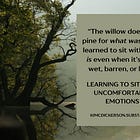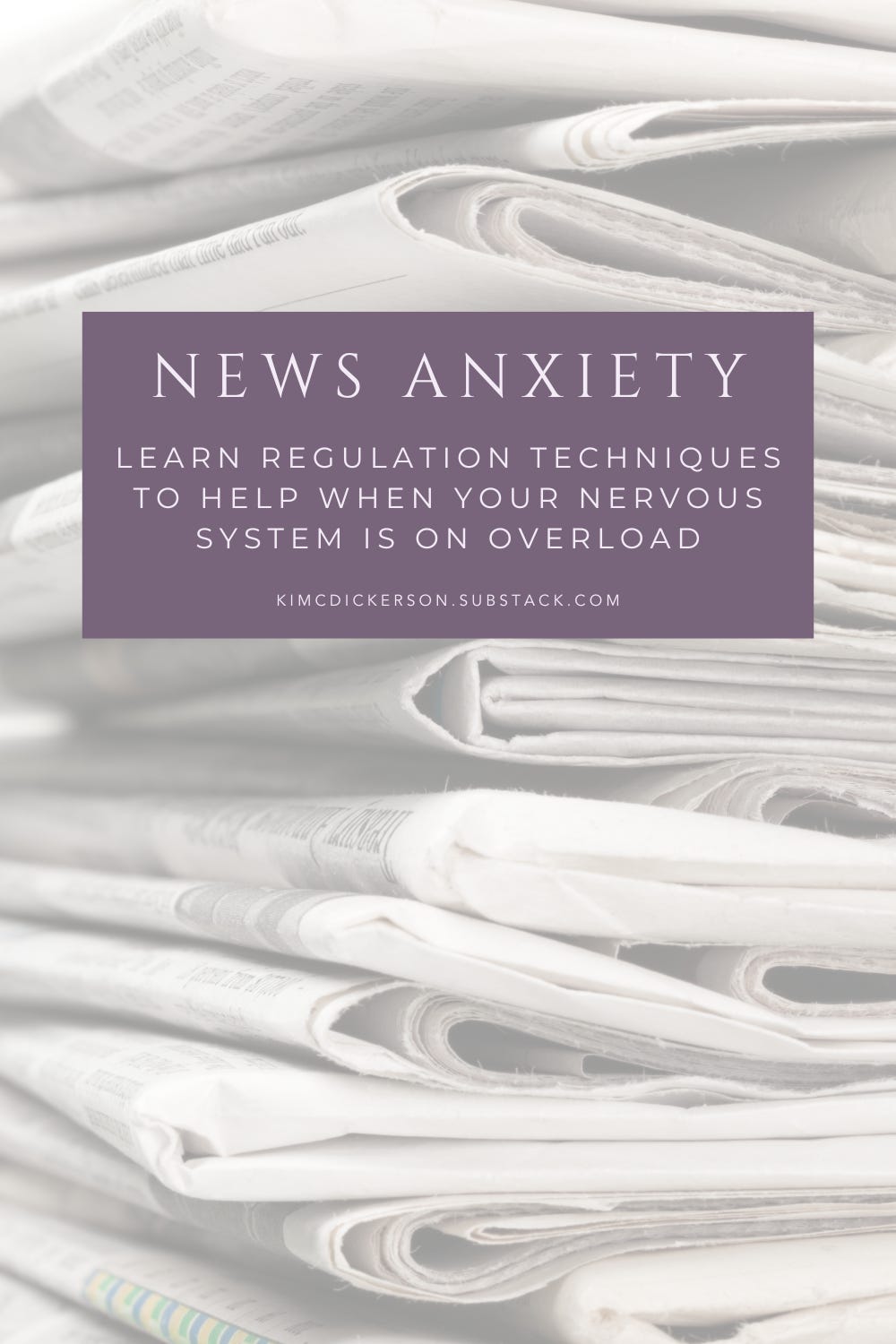News Anxiety: A Nervous System On Overload
The Anatomy and Physiology Behind It and What You Can Do About It
Backward Facing Therapy contains soulful and insightful stories from my time as both a therapist and a therapy client. Sit by me as we work on our mental health together. Paid subscribers get access to downloadable workbooks, worksheets, journals, and more in Kim’s Therapy Space.
Posts are informational and should not be considered a substitute for professional health care.
“I read the news today, oh, boy...”
A Day in the Life, The Beatles
There’s a certain kind of exhaustion that comes from keeping one eye on the world and one hand over your heart. A helpless ache that settles into your bones when you're trying to stay informed and stay intact. That’s the quiet toll of news anxiety, and if you’ve been feeling it lately, you’re far from alone.
I feel it when I read about the suffering in Gaza and Ukraine.
I feel it when I hear about a mother being ripped away from her children during immigration raids.
I feel it when I read dehumanizing rhetoric aimed at already marginalized groups of people.
It’s a lot.
And our nervous systems are not meant to function in 24/7 news cycles. Yet here we are.
Our bodies were designed to notice danger, respond, and then return to safety, but what happens when the danger never seems to end? When the headlines bleed into each other and the grief just keeps coming?
To understand why we’re feeling overwhelmed, we need to look at our anatomy, our physiology, and the part of us that’s just trying to keep us safe.
The Body’s Alarm System
When your eyes read a troubling headline, your brain doesn’t pause to check if the threat is real or imagined, far away or close by.
It just sees danger.
This activates your HPA axis:
Hypothalamus
Pituitary gland
Adrenal glands (Source)
Together, these three form your body’s stress-response command center. Once activated, the HPA axis releases stress hormones cortisol and adrenaline, which prepare your body to fight, flee, or freeze.
This is useful if you’re running from a physical threat, but in the face of ongoing perceived threats (e.g., war, civil unrest, climate disasters, political turmoil), this alarm system stays on. Your body doesn’t get a chance to calm down, come down, or chill out.
You might notice:
Racing thoughts
Tight chest
Trouble sleeping
Digestive issues
Emotional numbness, panic, anxiety
This is your body trying to protect you, over and over, without resolution.
No wonder we’re tired. And these days? I’m chronically tired.
What Do We Do?
Since we can’t shut off the world, all we can do is work with what we have: our nervous system.
To quiet our nervous system (and our body’s alarm system), we need to start by telling ourselves that right now, we are safe. We are not in danger. We are safe, we are safe, we are safe. We are not in danger.
This mantra isn’t going to fix everything, but it will send a message to your brain that the HPA axis can take a break.
Seriously, no more adrenaline and cortisol, please. We’ve had enough.
Once you’ve told yourself that you are safe, you can move on to other nervous system-regulating activities.
Nervous System Regulation Techniques
1. The 3-3-3 Rule
When your mind is racing, pause and name:
3 things you can see
3 things you can hear
3 parts of your body you can feel (feet on the ground, back against the chair)
This anchors your attention in the present moment. Remember, you are safe and in no danger.
***Note: If you’re a paid subscriber, you can download a printable copy of the 5 Things Grounding Technique in Kim’s Therapy Space.
2. News Boundaries (Digital Hygiene)
No news within the first or last hour of your day.
Pick one reliable news source and avoid doom-scrolling.
Learn about seven therapeutic strategies to help you during times of uncertainty
3. Hand on Heart Breathing
Place your hand over your heart. Inhale gently for four seconds, exhale for six seconds.
Whisper to yourself:
“Right now, I am safe. My body is breathing. My heart is steady. I accept love.”
4. Vagus Nerve Activation (Polyvagal-Informed Practices)
Humming or singing: Stimulates the vagus nerve through vibration.
Splash cold water on your face or hold a cool compress to the back of your neck.
Gargling or chanting “OM” can help tone the vagus nerve, signaling safety to your body.
5. Orienting to Safety
Look slowly around your space. Name comforting things you see—a plant, a favorite book, a soft pillow, your cat. Let your body absorb the quiet message:
“This moment is not a threat.”
6. Bilateral Movement
Cross-body movement (like walking, rocking side-to-side, or drumming your hands left–right) soothes the nervous system and helps process emotion.
7. Self-Holding Practice
Wrap your arms around yourself. Place one hand on each shoulder or your upper arms and apply gentle pressure. This “butterfly hug” sends signals of safety and containment to your brain. It may sound weird, but it’s the original self-hug.
8. Co-Regulation (Even from Afar)
Call a friend and talk about it.
Watch a calming nature video found on YouTube, a cute puppy or kitten video, or find some soothing ASMR sounds.
Sit beside someone quietly (pets count). My cats have been a great source of calm for me. There’s something about that rhythmic purring…
9. Nature Attunement
Go outside. Touch a tree bark. Feel the sun on your face. Watch clouds pass.
If this isn’t an option, gazing out a window for 60 seconds can bring your body’s alert system from threat to presence.
10. Scent and Sound Anchors
Light a candle with a soothing scent like lavender, vanilla, or linen.
Put on soft instrumental music or nature sounds.
These subtle cues remind your senses that you’re not in a crisis, even if your heart feels otherwise.
Remember, you’re not alone in your news anxiety. Your body is responding exactly as it is supposed to in a world that was never meant to flood us with distressing headlines every waking hour.
The good news? Just as your body can spiral into stress, it can also be invited back into calm. Through grounding. Through stillness. Through mindful limits on what you consume and when. Through remembering that you do not have to carry the weight of the world to care about it.
You can care and still rest.
You can be informed and still protect your peace.
You can feel upset, discouraged, angry, anxious, or stressed AND still find moments of beauty, joy, and hope.
This is all just part of the human experience and not a signal that you’re broken.
Journal Prompts
What does my body feel like after reading the news? What sensations or emotions show up?
What is mine to carry, and what can I gently set down?
How can I stay informed without sacrificing my mental well-being?
Becoming a paid subscriber is the best way to support my work, but you can also buy me a coffee or send a dose of mindfulness. Shares, likes, and comments are also a way to show your support. Either way, I’m glad you’re here.
Be well,
Kim
Recommended reading:
{FOR YOUR PINTEREST BOARD TO SAVE FOR LATER}











love all the practical simple tips! thank you so much!